#saint brigid
Text

Happy Imbolc!

And happy St Brigid’s Day or in this case Bridget’s Day. Here’s to new beginnings and turning the corner towards better days!
358 notes
·
View notes
Text
Important Facts about Imbolg from an Irish Celtic Reconstructionist

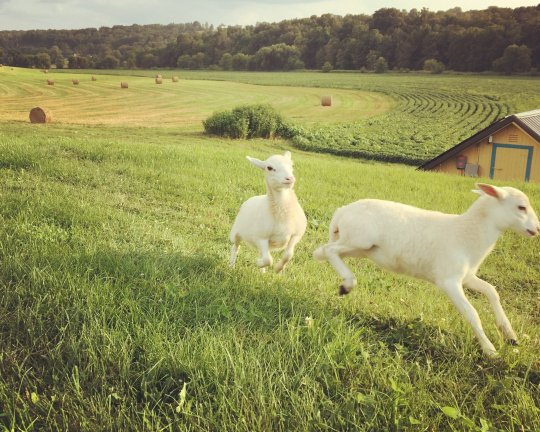

Spelling and Pronunciation
Imbolc, as it is often written, or Imbolg, as it is written in older texts is pronounced like Im-bolɤg, for only English speakers think of that ending g/c sound as being a back of the mouth guttural sound (similar to ‘ch’ in loch)
Dates
Most reconstructionists celebrate Imbolg on Jan 31- Feb 1, while others choose to observe it on the first day of the month by the Julian Calander (which currently is a difference of about 13 days), from sundown to sundown. However in the most “traditional” sense this festival has been linked to the first birthing of lambs.
Importance in the Mythos
Imbolg is not discussed extencively in the mythological texts of Ireland but a 10th century version of Tochmarc Emire names Imbolc and lists it as taking place “when the ewes are milked as spring’s beginning”
Celebration Traditions
These days Imbolg is deeply intertwined with the celebrations of St. Brigid’s day. This is obviously most likely because Brigid the Pre-Christian goddess was replaced in the hearts and minds of the Irish by her Saint iteration and as such her festival was also commandeered.
It is now most often associated with things like the healing springs of Ireland (which had sacred properties before Christianity and likely were part of the festival before it was Christianized), the hearth flame (though this is likely from Kildare’s St. Brigid’s cult more so than the Pre-Christian iteration of Brigid), Brigid’s crosses and dolls and Brigid “visiting” homes and birthing beds named after her. It is almost impossible to definitively say which if any of these practices may have grown out of the activities and practices of the Pre-Christian festival and which originated only with St. Brigid.
Art Credit @feyspeaker
#Imbolc#Imbolg#Irish#irish mythology#irish polytheism#irish paganism#celtic reconstructionism#celtic paganism#celtic mythology#celtic polytheism#goddess brigid#saint brigid#brigid#fire festival#blackcrowing#irish reconstructionist#irish reconstructionism
324 notes
·
View notes
Photo

Saint Bride by John Duncan
38 notes
·
View notes
Text
Ode to Brighid
"O Brighid, fair daughter of the Good God,
Smith of shining silver and silvered songs,
The badgers, the snowdrops, they breach the snow:
Winter's crystal mantle, to welcome you,
Goddess! Patron of poets and plowmen alike
Take my prayer, let it be fuel for the flame."

[original composition]
#celtpol#brighid#brig#brigit#brigid#imbolc#saint brigid#prayer#pagan prayer#pagan poetry#tuatha de danann#from the writing desk
154 notes
·
View notes
Text

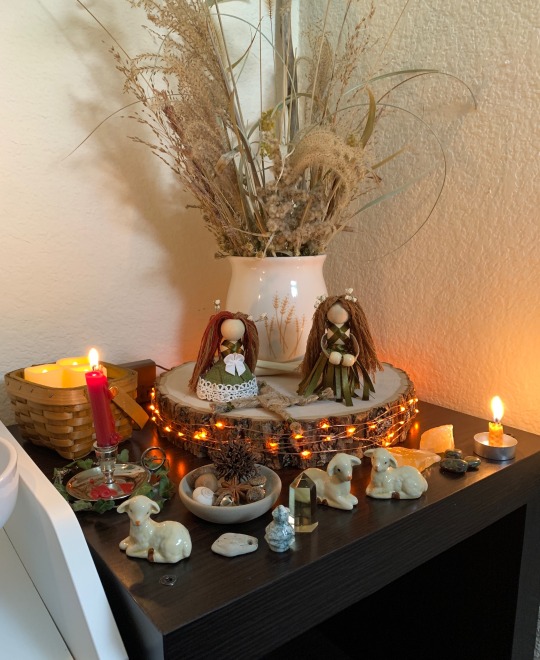
Blessed Imbolc to all 🌟🕯️🤍🔥🌾
#imbolc#imbolg#altar#altar ideas#witch altar#pagan holidays#brigid#saint brigid#candlemas#my stuff#witchblr#witch community#baby witch#witchcraft
27 notes
·
View notes
Text
Absolutely hate that "Saint Brigid of Kildare is actually a pagan goddess" has become generally accepted as fact when the evidence that most people use to confirm this is that A) she has the same name as an Irish goddess (maybe) and B) they're both Irish religious figures.
For comparison, this is a bit like claiming Saint Dionysus the Aeropagite is just Christianized Greek god Dionysus because A) they have the same name and B) they're both Greek.
90 notes
·
View notes
Text

Brigida, the Smith Sister
Brigida has three major forms, the healer, the poet, and the smith. Sometimes they are seen as sisters, sometimes as three heads on a single body. Here the smith dances in her sun-forge, her hands and feet black from soot, dancing barefoot.
Inktober prompt: golden was just too fitting for her, The Exalted Light @inktober
#santa brigida#saint brigid#st brigid#goddess brigid#celtic#irish mythology#celtic mythology#inktober 2023#inktober golden#inktober day 6#inktobergolden#inktober
39 notes
·
View notes
Text
About Candlemas

It's the middle point between the winter solstice and the spring equinox. In French, there is a proverb: "A la chandeleur, l'hiver meurt ou reprend vigueur". " At Candlemas, winter dies or come back stronger". It's sure it will come back if, paradoxically, it's sunny on February the 2nd. If groundhogs see their shadows, you know...

Or bears. Groundhog or bear tradition has pretty much died here, but for a while in Europe Candlemas was called "Bear day", as people watched if bears stopped their hibernation on this day.

Crêpes tradition is ubiquitous there, because of an obvious symbolism (crêpes are round and golden like the sun). It certainly comes from pagan traditions, but reused after Christianity arrived.
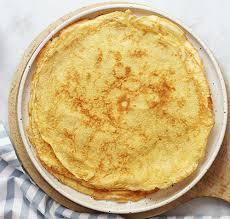
Candlemas is the day of Jesus presented at the temple, and mainly, the tradition was to come back from the church with a candle.

Said candle brought protection, and was lit during storms, notably.

And of course there are the Brigid crosses.

And ta dah, this time I could make mine:

#witch#witchy#witchcore#witchcraft#witch aesthetics#witch aesthetic#witch core#witches#witchblr#aesthetics#candlemas#imbolc#saint brigid
15 notes
·
View notes
Text

Happy Saint Brigid’s Day.
13 notes
·
View notes
Text

Saint Brigid's Cathedral, Kildare Town, Ireland and the round tower and high cross on a sunny day.
#ireland#vsco#landscape#vscocam#irish#photographers on tumblr#photography#travel#kildare#gaa#squires gannon#panorama#panoramic ireland#county kildare#irish buildings#heritage#saint brigid#saint brigid's cathedral#round tower#sam maguire cup
42 notes
·
View notes
Text
Imbolc
Imbolc is celebrated from February 1st until sundown on February 2nd and signifies the beginning of spring in the Celtic calendar. Imbolc marks the halfway point between the Winter Solstice and the Spring Equinox and is one of several Pagan festivals that highlight some aspect of winter and sunlight to herald the change of seasons.
The celebration of Imbolc dates to pre-Christian times and the earliest mentions in Irish literature are found in the 10th century. Poetry from that time connects the holiday to ewe’s milk, with the implication of purification. As this ritual stems from the breeding cycle of sheep and the beginning of lactation, Imbolc traditionally aligned with the first day of spring and the idea of rebirth. The most common explanation for the etymology of Imbolc is from the Old Irish i mbolc meaning 'in the belly' and refers to pregnant ewes at this time of year.
In Neolithic times, Imbolc celebrations honoured the Pagan goddess Brigid, who was invoked in fertility rites and was also the goddess of poetry, crafts, and healing. Brigid was worshipped by the Filidh, the Celtic poets and historians of ancient Ireland. Brigid is one of the most powerful Celtic gods and is the daughter of the Dagda, the oldest god in the Celtic pantheon of the Tuatha Dé Danann. Modern-day Pagans set up an Imbolc altar to celebrate Brigid with a corn husk doll, white flowers, a bowl of milk, and candles. A group gathering casts a circle and recites invocations to receive a blessing from Brigid.
Brigid was said to visit homes on the eve of the Imbolc festival. To receive her blessings, an effigy of the goddess was crafted from rushes and oats, clad in pieces of cloth and flowers, and put in a basket overnight, with gifts of food and drink. Brigid was evoked to protect homes and livestock and items of clothing were left outside for her to bless. On Imbolc, the effigy of Brigid, known as a Brídeóg or Biddy, was paraded around the community by girls and young women. Sometimes, a young girl took on the role of Brigid and went from house to house wearing a crown, and carrying a shield, both made from rushes.
Over the centuries, Brigid was adopted by Christianity as Saint Brigid to become one of Ireland’s three patron saints along with Saint Patrick and Saint Colmcille. Saint Brigid is said to have lived in the 6th century and founded the important monastery of Kildare. While there are many stories about her, there are few historical facts. In the 12th century, legend holds that the nuns in Kildare attended to a fire built in Saint Brigid’s honour. The fire had burned for 500 years and produced no ash, and only women were allowed in proximity of the fire.
Imbolc rituals still include burning lamps and lighting bonfires in tribute to Brigid, who is associated with both milk and fire. Although there is some debate that Saint Brigid was a separate historical figure who shares the same name as the Celtic goddess, many scholars maintain that they are the same person with the later saint based on the earlier Pagan deity. As with many Pagan traditions and festivals, the names and dates were often adopted by Christianity to make the new faith more acceptable.
Imbolc is also believed to be when the Cailleach, the divine hag of Gaelic tradition, gathers firewood for the rest of winter. If she wishes to make the winter last longer, the weather on Imbolc is bright and sunny, so she can gather plenty of firewood. However, if Imbolc is a day of bad weather, it means the Cailleach is asleep, and winter is almost over.
On February 1st, people display a Brigid’s cross woven from rushes gathered by rivers and ponds. Traditionally, the cross is set over doorways and windows to welcome Brigid and protect the home from any kind of harm. Brigid’s Day parades and “Biddy’s Day” festivals are still held in some towns around Ireland, and it is also traditional to visit a holy well, praying for good health while walking clockwise around the well.
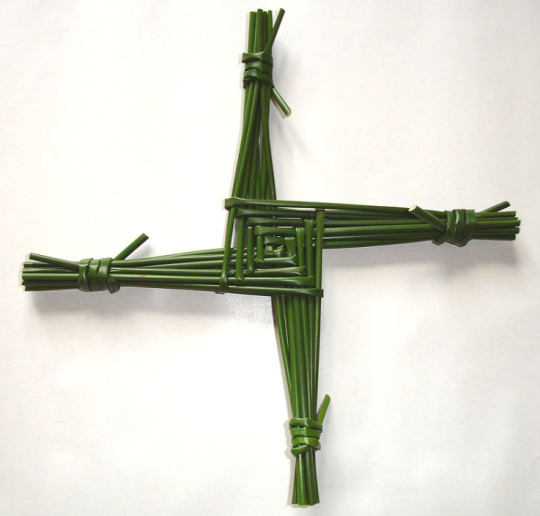

108 notes
·
View notes
Text
‼️BREAKING‼️
shauna shipman’s favourite saint is St. Anthony!! the patron saint of lost things, amputees, animals, oppressed people, poor people, pregnant women and shipwrecks to name a few!!
also St. Brigid who is the patron saint of midwives, newborns, fugitives, scholars + more!!!
#daisys whimsical words#yellowjackets#yj#shauna shipman#sorry#had to break out my catholicism#saint anthony#saint brigid#UGH SAINT ANN#okay sorry#SAINT ANN#JESUS CHRIST#omg#no#okay#it’s okay#it is
16 notes
·
View notes
Text
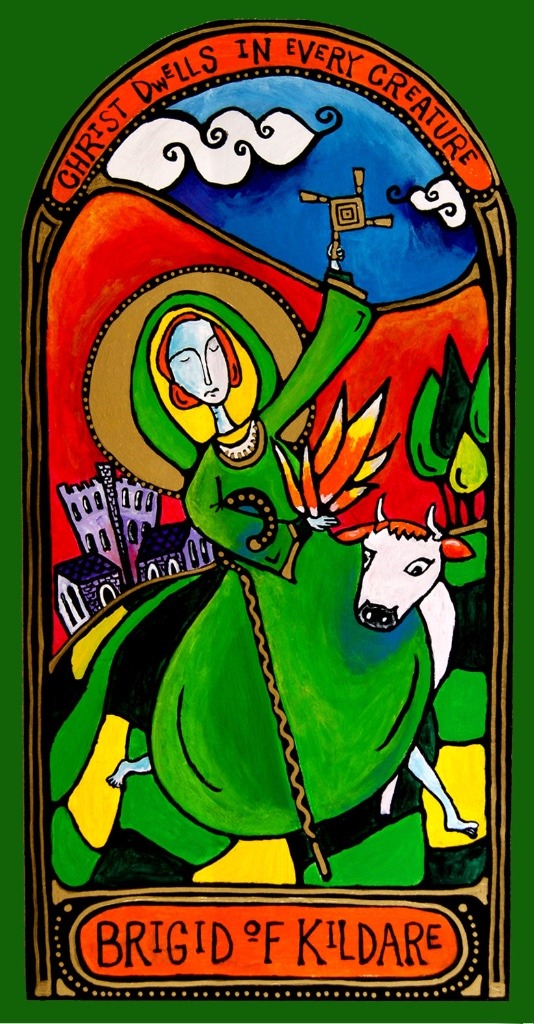
Dancing monk icon by Marcy Hall Art
* * * *
Blessings on this eve of the Feast of St. Brigid!
I feel especially blessed to have had the joy of joining with a group of dancing monks online last Monday to celebrate Brigid's call to us as midwife, muse, and transforming fire.
February 1st-2nd marks a confluence of several feasts and occasions including: the Celtic feast of Imbolc, St. Brigid’s Day, Candlemas, Feast of the Presentation, and Groundhog Day in the northern hemisphere! (Imbolc is August 1st in the southern hemisphere).
Imbolc is a Celtic feast that is a cross-quarter day, meaning it is the midway point between the winter solstice and spring equinox. The sun marks the four Quarter Days of the year (the Solstices and Equinoxes) and the midpoints are the cross-quarter days. In some cultures, like Ireland, February 2nd is the official beginning of spring.
As the days slowly lengthen in the northern hemisphere and the sun makes her way higher in the sky, the ground beneath our feet begins to thaw. The earth softens and the seeds deep below stir in the darkness. The word “imbolc” means “in the belly.” The earth’s belly is beginning to awaken, new life is stirring, seeds are sprouting forth.
In many places the ground is still frozen or covered with snow, but the call now is tend to those very first signs of movement beneath the fertile ground. What happens when you listen ever so closely in the stillness? What do you hear beginning to emerge?
St. Brigid is said to bring the first sign of life after the long dark nights of winter. She breathes into the landscape so that it begins to awaken. Snowdrops, the first flowers of spring are one of her symbols.
On the eve of January 31st it is traditional to leave a piece of cloth or ribbon outside the house. It was believed that St Brigid’s spirit traveled across the land and left her curative powers in the brat Bride (Brigid’s Mantle or cloth). It was then used throughout the year as a healing from sickness and protection from harm.
Often in Ireland, I have heard Brigid described as a bridge between the pre-Christian and Christian traditions, between the other world and this one. She bridges the natural and human world. Brigid sees the face of Christ in all persons and creatures, and overcomes the division between rich and poor. Our practice of inner hospitality as monks in the world is essentially about healing all of places we feel fragmented, scattered, and shamed. One of her symbols is her cloak which becomes a symbol of unity. All can dwell under her mantle.
[Thanks to Christine Valters Paintner and to the dancing monks]
#Saint Brigid#Ireland#the Dancing Monks#Christine Valters Paintner#celtic christianity#imbolc#in the belly#seasons#winter#feast days
8 notes
·
View notes
Text


Have a blessed Imbolc everyone 🌙✨
#pagan witch#witchcore#welsh witch#witchythings#witchcraft#baby witch#pagan altar#paganblr#imbolc#witch aesthetic#witchblr#beginner witch#house witch#ok to rb#saint brigid
60 notes
·
View notes
Text
IMBOLC
Also referred to as Imbolg or Candlemass

When is Imbolc?
Typically celebrated between February 1st to February 2nd.
What does Imbolc mean?
It is a celebration of rebirth, fertility, and the arrival of the lambing period of sheep. It is considered the halfway point between the winter solstice and the spring equinox, celebrating the near arrival of springtime.
Who does Imbolc celebrate?
The Goddess Brigid is honored at this time, who is the goddess of fertility, hearth, poetry, and smithcraft.
—————
IMBOLC TRADITIONS
Work with stones that promote fertility, healing, and/or creativity, such as moonstone, amethyst, carnelian, rose quartz, malachite, clear quartz, and turquoise.
Utilize aromatic herbs and flowers such as cinnamon, basil, angelica, daffodil, plumeria, and myrrh, which are known to be mood-boosters, diaphoretic, and aid with quelling anxiety. Daffodils specifically symbolize “new beginnings.”
Create or consume diary products such as cheese, cow’s or sheep’s milk. Imbolc is the celebration of lambing, after all! Sweet berries such as blackberries and strawberries are also good choices.
Wear or decorate with brown, beige, white, ochre, and gold colors.
Incorporate animal imagery (e.g., drawings, photographs, figurines, et cetera) of sheep, cows, and swans, symbolizing the Goddess Brigid’s connection to animals. These animals are specifically associated with love and fertility.

IMBOLC ACTIVITIES
Burn candles to symbolize the welcoming of light and warmth of the forthcoming springtime. Burning herbs and palo santo can aid with cleansing and purifying around you.
Take a ritual bath: add one cup of milk, dehydrated strawberries, and a couple drops of rose hip oil to your bath.
Create or purchase Brigid’s Cross. Place it on an altar or near your front or bedroom door for protection. You can make one out of rushes or paper!
youtube
Indulge in creative endeavors, whether it be painting, sewing, poetry, journaling, singing, metalworking, playing and instrument, et cetera. The Goddess Brigid is specifically associated with poetry and writing as well as working with metals.
Appreciate nature. Take a walk around your neighborhood or a park; engage in outdoor activities; or take photographs, draw observations, jot down notes and observances, or simply introspect.
Plant seeds of your chose in your garden to represent birth and growth, and foster a connection to nature.
Get creative with recipes! Carlota Santos, who is the author of Magika, recommends a simple strawberry milkshake or baking a blueberry and chocolate cream cake.
Carlota Santos’ Imbolc Cake Recipe

#imbolc#imbolg#celtic holidays#witchcraft#february#love and fertility#rebirth#goddess brigid#saint brigid#witchblr#paganism
6 notes
·
View notes
